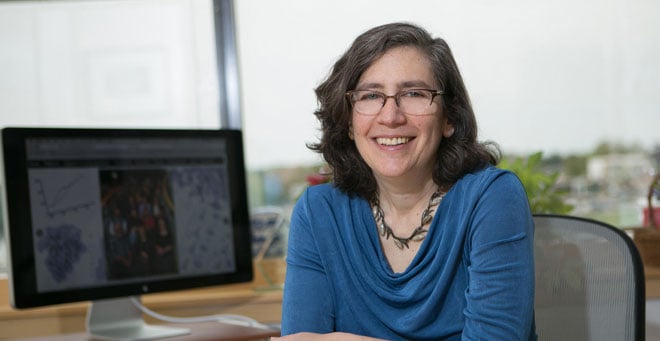 |
|
|
Celia A. Schiffer, PhD |
Celia A. Schiffer, PhD, professor of biochemistry & molecular pharmacology and director of the Institute for Drug Resistance at UMass Medical School, is taking part in a $5.8 million National Institutes of Health-funded collaboration to develop a protective vaccine against avian influenza A. The collaboration is led by EpiVax, Inc., a leader in the field of immune engineering.
First identified in a human in 2013, avian influenza A, also known as H7N9 for the particular surface protein signature, is a strain of flu that typically circulates among poultry. Occasionally, the H7N9 virus will infect a human. As of Oct. 26, the World Health Organization has reported a total of 1,564 human H7N9 infections, with a 40 percent mortality rate. While mutations that would enable sustained human-to-human transmission by H7N9 have not yet occurred, the Centers for Disease Control and Prevention placed the virus at the top of the risk scale for both emergence and potential for significant pandemic impact should human-to-human transmission happen.
An expert in structural biology, Dr. Schiffer and colleague Nese Kurt Yilmaz, PhD, assistant professor of biochemistry & molecular pharmacology, will work with scientists with a wide range of influenza expertise across immunology, vaccinology, structural biology, bioinformatics, animal infection models and vaccine manufacturing at EpiVax, Sanofi Pasteur and the University of Georgia to develop a new vaccine capable of eliciting an immune response strong enough to protect humans from a new, high-mortality, avian influenza.
The H7N9 strain is distantly related to seasonal influenza and has been a challenge for traditional influenza vaccines, which rely on prior exposure to be effective. Potential vaccines targeting the H7N9 strain have been minimally effective without adjuvant. In contrast with recent vaccines for seasonal influenza (H1N1), H7N9 vaccines have generated very low immune responses. Seroconversion rates—a standard measure of vaccine effectiveness—of only 6 percent and 15.6 percent have been reported in phase I clinical trials for recent attempts at an avian flu vaccine, compared to 89 percent for similar seasonal H1N1 vaccines.
Using bioinformatics and molecular modeling methods, the collaborators aim to engineer the H7N9 hemagglutinin protein to resemble seasonal flu, a process designed to engage immunological memory and make conventional hemagglutinin-focused flu vaccines protective against a new, potentially high-mortality avian influenza.
Schiffer and her lab will help assess potential vaccine candidates for structural stability.
“My lab focuses on how structure impacts function—whether elucidating the molecular basis for resistance or designing better vaccines,” said Schiffer. “By elucidating how to stabilize the structure of hemagglutinin, we hope to provide insights into potential vaccine candidates that likely provide much better protection to patients against the H7N9 virus.”
Related stories on UMassMedNow:
NIH awards Schiffer $7.9 million to attack drug resistance
Expert’s Corner: Celia Schiffer, PhD, on drug resistance